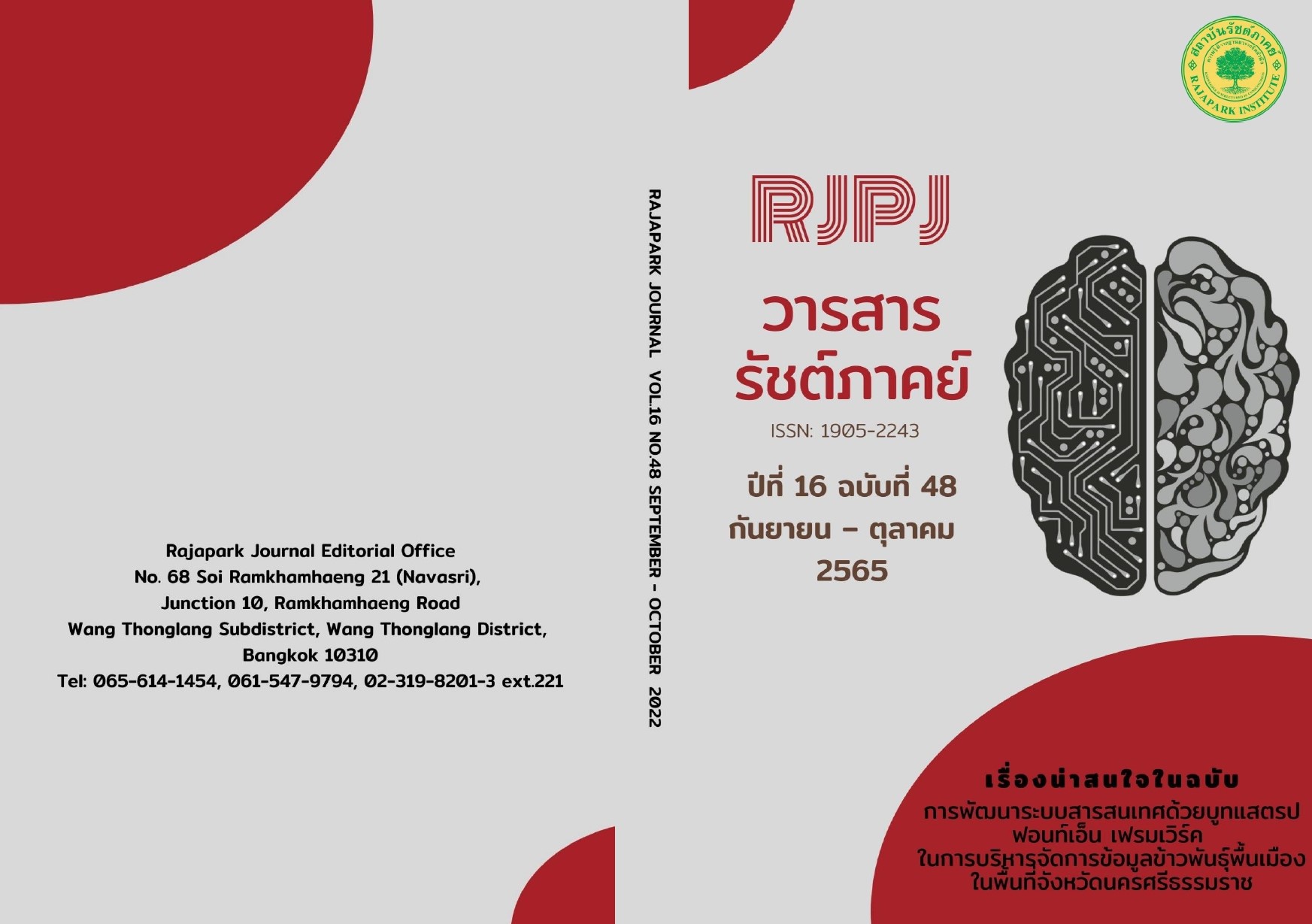การพัฒนาการท่องเที่ยวเชิงสร้างสรรค์เพื่อเพิ่มเสน่ห์วิถีชุมชน จังหวัดปทุมธานี
Main Article Content
บทคัดย่อ
การวิจัยนี้มีวัตถุประสงค์เพื่อศึกษา 1) ระดับการท่องเที่ยวเชิงสร้างสรรค์ในด้านบริบทชุมชน การสร้างเครือข่ายการท่องเที่ยว การมีส่วนร่วมของนักท่องเที่ยว และการบริหารจัดการ 2) อิทธิพลของบริบทชุมชน การสร้างเครือข่ายการท่องเที่ยว การมีส่วนร่วมของนักท่องเที่ยว และการบริหารจัดการที่มีผลต่อการท่องเที่ยวเชิงสร้างสรรค์ จังหวัดปทุมธานี และ 3) แนวทางการพัฒนาการท่องเที่ยวเชิงสร้างสรรค์เพื่อเพิ่มเสน่ห์วิถีชุมชน จังหวัดปทุมธานี โดยใช้วิธีการวิจัยแบบผสมผสาน การวิจัยเชิงปริมาณเก็บข้อมูลด้วยแบบสอบถามแบบมาตราส่วนประมาณค่า 5 ระดับ กับกลุ่มตัวอย่าง คือ ประชาชนที่พักอาศัยอยู่ในจังหวัดปทุมธานี จำนวน 300 ตัวอย่าง โดยการสุ่มแบบชั้นภูมิ วิเคราะห์ข้อมูลด้วยแบบจำลองสมการโครงสร้าง การวิจัยเชิงคุณภาพ สัมภาษณ์เชิงลึกกับผู้ให้ข้อมูลสำคัญ จำนวน 17 ราย วิเคราะห์เนื้อหาร่วมกับผลการวิจัยเชิงปริมาณ ผลการวิจัยพบว่า 1) ค่าเฉลี่ยของตัวแปรในเรื่องระดับการพัฒนาการท่องเที่ยวเชิงสร้างสรรค์ทั้งหมด อยู่ในระดับมาก 2) การสร้างเครือข่ายการท่องเที่ยวมีอิทธิพลสูงสุดต่อการพัฒนาการท่องเที่ยวเชิงสร้างสรรค์ จังหวัดปทุมธานี และ 3) แนวทางการพัฒนาการท่องเที่ยวเชิงสร้างสรรค์เพื่อเพิ่มเสน่ห์วิถีชุมชน จังหวัดปทุมธานี ทั้งหน่วยงานภาครัฐ ภาคเอกชนและภาคประชาชนควรร่วมมือกันสร้างเครือข่ายการท่องเที่ยว บริหารจัดการ ทำแผนปฏิบัติการพัฒนาแหล่งประวัติศาสตร์ ศิลปวัฒนธรรมไทย มรดกทางวัฒนธรรม อาหารไทย กิจกรรมและสินค้าของชุมชนและร่วมกันขับเคลื่อนนโยบาย ปฏิบัติอย่างเป็นรูปธรรมนำไปสู่การพัฒนาจังหวัดปทุมธานีให้เป็นแหล่งท่องเที่ยวเชิงสร้างสรรค์
Article Details

This work is licensed under a Creative Commons Attribution-NonCommercial-NoDerivatives 4.0 International License.
ทัศนะและความคิดเห็นที่ปรากฏในวารสาร ถือเป็นความรับผิดชอบของผู้เขียนบทความนั้น และไม่ถือเป็นทัศนะและความรับผิดชอบของกองบรรณาธิการ
References
Baggio, R. (2008). Symptoms of complexity in a tourism system. Tourism Analysis, 13(1), 1-20.
Banchongkarn, B., Sitchindah, P., & Puangsuk, P. (2012). Effects on people in the coastal area of Chanthaburi Province From the construction of Chalerm Burapha Chonlathit Road. Rambhai Barni Rajabhat University.
BORA-The Bureau of Registration Administration, (2020). Population Statistical Data Structure. https://stat.bora.dopa.go.th/new_stat/webPage/statByYear.php
Chaibin, K., Aiyakorn, S., & Romyen, L. (2020) (2020). Factors affecting public participation in promoting Nawatwithi OTOP tourism community in Na Thom district, Nakhon Phanom Province. Journal of Graduate School, 17(79), 158-170. https://so02.tci-thaijo.org /index.php/SNGSJ/article/view/242697/166829
Chinachot, P., & Chantuk, T. (2016). Model of creative tourism management in Suan Phueng. Veridian E-Journal, Silpakorn University, 9(1), 250-268. https://he02.tci-thaijo.org/index.php/Veridian-E-Journal/article/view/52759/43803
Cronbach, L.J. (1990). Essentials of Psychological Testing (5th ed). Harper Collins.
DASTA-Special Area Development Administration Organization for Sustainable Tourism. (2013). Assessment Report according to the performance testimonials of Special Area Development Administration for Sustainable Tourism DASTA. https://www.dasta.or.th/th
Dickman, C.R. (1996). Overview of the Impacts of Feral Cats on Australian Native Fauna. Australian Nature Conservation Agency.
Ding, L., Velicer, W.F., & Harlow, L.L. (1995). Effects of Estimation Methods, Number of Indicators per Factor, and Improper Solutions on Structural Equation Modeling Fit Indices. Structural Equation Modeling, 2(2), 119-144.
Gliem, J.A., & Gliem, R.R. (2003) Calculating, Interpreting, and Reporting Cronbach’s Alpha Reliability Coefficient for Likert-Type Scales. In 2003 Midwest Research to Practice Conference in Adult, Continuing, and Community Education, Columbus, 82-88.
Hair, J.F., Black, W.C., Babin, B.J., & Anderson, R.E., (2010). Multivariate data analysis: A global perspectives. Pearson.
Kaewsanga, P., & Chamnongsri, N. (2012). Creative tourism: a new alternative for Thai tourism. Suranaree Journal of Social Science, 6(1), 91-109. https://so05.tci-thaijo.org/index.php/sjss/article/view/23437/19969
Kasikorn Research Center. (2021). SME Tourism Business. Kasikorn Research Center. https://www.kasikornresearch.com/th/analysis/k-econ/business?c=362
Lamviriyawat, P. (2018). Strategy Development for Community Elevation to Creative Tourism of Ban Phu Nam Ron, Dan Chang District, Suphan Buri Province. Dusit Thani College Journal, 14(2), 433-451.
Li, P., Wang, F., Zheng, X., & Huang, J. (2020). Influencing factors and mechanism of urban community tourism development: A case study of Beijing. Sustainability, 12, 2806.
Likert, R. (1932). A Technique for the measurement of attitudes. Archives of Phycology, 140, 1-55.
Ministry of Tourism and Sports Thailand. (2021). 20-Year Tourism Vision. National Tourism Development Plan No. 2. https://secretary.mots.go.th/policy/more_news.php?cid=25
Phiriyasuvat, J., Phraratprichamuni., Phratanakorn Santamano., & Wanna, A. (2018). The Building of Cultural TourismNetworksbetweenChiang KhanDistrict, Loei Province, Thailand and Luang Prabang City, Lao PDR. Journal of MCU Ubon Review, 5(1), 158-169. https://so06.tci-thaijo.org/index.php/mcjou/article/view/240215/164245
Richards, G. (2009) Creative tourism and local development. In: Wurzburger, R., Pattakos, A. and Pratt, S. (eds) Creative Tourism: A global conversation. Santa Fe: Sunstone. Pp.78-90.
Richards, G., & Raymond, C. (2000). Creative Tourism. ATLAS News, 23(1), 16-20. https://www.academia.edu/1785786/Creative_Tourism_Richards_and_Raymond_2000
Rittima, W., Thanapitak, W., & Kiriratnikom, A. (2021). Sustainable of arable land management in conservation forest at Banthat Range Phatthalung Province Area. NRRU Community Research Journal, 15(1), 29-41. https://so04.tci-thaijo.org/index.php/NRRU/article/view /244120/169219
Rovinelli, R.J., & Hambleton, R.K. (1976). On the use of content Specialists in the assessment of criterion-referenced test item validity. In Laboratory of psychometric and Evaluative research report No. 24. Amherst, Mass: The University of Massachusetts. https://files.eric.ed.gov/fulltext/ED121845.pdf
Suvarnakuta, K., Benchatikul, K., & Jaroenroop, N. (2018). The Mobilization Styles of Creativity Tourism Management: Case Study of Agro-tourism Management in Rayong and Chanthaburi Province. Rambhai Barni Rajabhat University.
Suwannapa, C., & Atthawong, A. (2016). Lilit Pra lor: Enhancing Learning and Social Ethics. Nakhon Phanom University Journal, 6(1), 52-60. https://so03.tci-thaijo.org/ index.php/npuj/article/view/53354/44289
Teeranon, S., & Sophonjaraskul, P. (2016). Creative Tourism: The Alternative - the Salvation of Thailand Tourism. Pathumthani University Academic Journal, 8(2), 11-18.
Thaveeseng, H. (2012). Creative tourism development: A case study of center of bird economy Yala city municipality[Master’s Thesis, Prince of Songkhla University]. https://kb.psu.ac.th/psukb/bitstream/2010/8888/1/365638.pdf
Timur, S. (2012). Analyzing urban tourism stakeholder relationship: A network perspective. http://torc.linkbc.ca/torc/downs1/AnalyzingUrbanTourismStakeholderRelationships.pdf.
UNESCO. (2006). Toward Sustainable Strategies for creative tourism. Discussion Report of the Planning Meeting for 2008 International Conference on Creative Tourism. Santa Fe, New Mexico. U.S.A.
Westland, J. C. (2010). Lower bounds on sample size in structural equation modeling. Electronic Commerce Research and Applications, 9(6), 476-487. DOI:10.1016/j.elerap.2010.07.003
Zhang, X., Song, H., & Huang, G. Q. (2009). Tourism supply chain management: A new research agenda. Tourism Management, 30(3), 345-358.
Zhou, W., Li-Yu, C., & Chou, R. (2021). Important factors affecting rural tourists’ aesthetic experience: A case study of zoumatang village in Ningbo. Sustainability, 13, 14.

